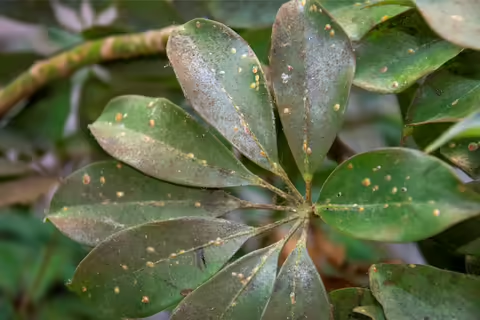URBANA, Ill. – As fall draws near, it’s time to bring houseplants inside for winter. Many houseplants are native to tropical and subtropical climates and do great outside in Illinois in the summer, but cannot tolerate cold temperatures.
“When temperatures drop below 55°F, it’s time to bring plants indoors,” says Ken Johnson, University of Illinois Extension horticulture educator. “Be sure you don’t also bring in unwelcome guests.”
Insects, such as aphids, whiteflies, scale, and spider mites are pests commonly found on outdoor plants. Inspect plants for any insects and other pests before bringing them indoors. Once inside, populations can rapidly increase and spread to other plants.
Before resorting to insecticides, spray foliage with a steady stream of water. “If spraying doesn’t work, insecticidal soaps can be used to eliminate soft-bodied insects,” Johnson says. "Follow label instructions.”
If plants are infested, it may be prudent to dispose of them.
In addition to the foliage, Johnson recommends checking the soil. Insects, such as earwigs and ants, will move into soil in potted plants. Flush pots with water to drive out insects. If ants are present, the plant may need to be repotted.
Over a period of about a week, gradually reduce light levels by moving plants to increasingly shadier areas. This will start to acclimate them to light conditions indoors. Once plants are indoors, put them next to the brightest, sunniest window, typically south or west facing. If you don’t have a sunny location, provide supplemental lighting.
Plants grow slower indoors, so will need less water and fertilizer. For most plants, allow the soil to dry slightly between watering, Johnson says.
“One way to check soil moisture is with your finger,” he says. “Stick your finger in your potting media up to your second knuckle. If the media is still moist, you don’t need to water.”
If the pot feels light when lifted, it may be time to water.
Plants can be watered by top or bottom. If top watering, apply enough water so that some water comes out the drainage holes at the bottom of the pot. This may need to be done more than once if the soil is very dry. If you have a saucer under the pot, make sure to empty the water out after half an hour or so. This will allow the potting mix to absorb additional water, but prevent the mix from becoming saturated.
To water from the bottom, fill you’re a plant saucer or sink with a few inches of water and let plants soak. Once the potting mix on the top of the pot is moist, the plant can be removed from the water.
Plants often drop leaves and yellow when they are moved indoors. Increasing humidity levels around plants and providing supplemental lighting can help reduce leaf drop, Johnson says. Over time, plants will acclimate to their new environment.
SOURCE: Ken Johnson, Horticulture Educator, Illinois Extension
ABOUT EXTENSION: Illinois Extension leads public outreach for University of Illinois by translating research into action plans that allow Illinois families, businesses, and community leaders to solve problems, make informed decisions, and adapt to changes and opportunities.
PHOTO ACCESS: The photo in this article is available to download for media use.
